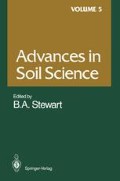Abstract
China has 25 million hectares of paddy soils, accounting for 25% of the total cultivated land in the country. Paddy (Oryza sativa) output amounts to 44% of the total grain output. These soils are characterized by a long history, varying types, and great productive potential.
Access this chapter
Tax calculation will be finalised at checkout
Purchases are for personal use only
Preview
Unable to display preview. Download preview PDF.
References
Brinkman R. 1970. Ferrolysis: A hydromorphic soil Geoderma 3: 199–206.
Chen H.Z. 1980. Geographical distribution of paddy soils in China. In Proceedings of a Symposium on Paddy Soil. Edited by Institute of Soil Science Academia Sinica. Science Press, Beijing, pp. 734–740.
Chu, L.T., Y.T. Ma, T.C. Sung, and KC. Hou. 1938. The Nomenclature of the various horizons of paddy soil. Special Soil Publication, China, Series B43, pp. 73–78.
FAO/UNESCO. 1974. Soil map of the world, 1:5,000,000, Vol. 1, Legend, Paris. Gong, Z.T. 1980. On the genetic classification of paddy soils in China. In: Proceedings of a Symposium on Paddy Soil. Edited by Institute of Soil Science Academia Sinica. Academia Simica. Science Press, Beijing, pp. 129–138.
Gong, Z.T. 1983. Pedogenesis of paddy soil and its significance in soil classification. Soil Sci. 135: 5–10.
Goswami, N.N., 1979. Phosphorus, potassium and other macroelements. In: Soils and Rice. IRRI, Manila, Philippines, pp. 561–576.
Grant C.Y. 1965. Soil characteristics associated with wet cultivation of rice. In: The mineral nutrition of rice plant John Hopkins Press, Baltimore, Maryland, pp. 15–28.
Hseung Y. 1941. Some chemical properties of paddy soils. Special Soil Publication, China, Series A4, pp. 1–22.
Kanno I. 1962. A new classification system of rice soils in Japan. Pedologist 6: 210.
Kamoshita, Y. 1954. Soil types in Japanese paddy rice field. Trans. 5th Int. Congr. Soil Sci. 4: 137–139.
Kawaguchi, K. and K. Kyuma. 1977. Paddy Soil in Tropical Asia. The University Press of Hawaii, Honolulu.
Matsui T. 1966. A proposal on a new classification system of paddy soils in Japan. Pedologist 10: 68–87.
Mitsuchi M. 1974. Pedogenic characteristics of paddy soil and their significance in soil classification (Engl. summary). Bull. Nat. Inst. Agr. Sci. B29: 29–115.
Mormann, F.R. 1980. The classification of “Paddy soils” as related to soil taxonomy. In: Proceedings of a Symposium on Paddy Soil. Edited by Institute of Soil Science, Academia Sinica. Science Press, Beijing, pp. 139–150.
Ponnamperuma, F.N. 1980. Some aspects of physical chemistry of paddy soils. Proceedings of a Symposium on Paddy Soil, Edited by Institute of Soil Science, Academia Sinica. Science Press, Beijing, pp. 59–90.
Tsao, S.K. 1964. The characteristics of paddy soil derived from red earth Jiangxi Province. Sinica Pedologica 12: 63–73. (in Chinese)
Wada, H., and S. Matsumoto. 1973. Pedogenic processes in paddy soils. Pedologist 17: 2–15.
Xu, Q., Lu Y.C., Liu, Y.C., Zhu H.G. 1980. The paddy soil of Taihu Region in China.Shanghai Scientific and Technical Publishers, Shanghai. (in Chinese)
Yamane, L. 1979. Electrochemical changes in rice soils. In: Soils & Rice. IRRI, Manila, Philippines, pp. 392–395.
Yang, X.Y. 1980. Geochemical characteristics of some transitional and rare earth elements in paddy soils of red earth region Guangzong Province. In: Proceedings of Symposium on Paddy Soil. Edited by Institute of Soil Science, Academia Sinica. Science Press, Beijing, pp. 754–758.
Yu, T.R. 1983. The physical chemistry of paddy soils. Science Press, Beijing, pp. 234–257.
Zhang, X.Q., Xi, Q. and Y. Hseung. 1983. Influence of soil water regime on the migration of mineral elements in soil and the crop growth. Acta pedologica Sinica 20 (4): 345–360 (in Chinese).
Author information
Authors and Affiliations
Editor information
Editors and Affiliations
Rights and permissions
Copyright information
© 1986 Springer-Verlag New York, Inc.
About this paper
Cite this paper
Zitong, G. (1986). Origin, Evolution, and Classification of Paddy Soils in China. In: Stewart, B.A. (eds) Advances in Soil Science. Advances in Soil Science, vol 5. Springer, New York, NY. https://doi.org/10.1007/978-1-4613-8660-5_4
Download citation
DOI: https://doi.org/10.1007/978-1-4613-8660-5_4
Publisher Name: Springer, New York, NY
Print ISBN: 978-1-4613-8662-9
Online ISBN: 978-1-4613-8660-5
eBook Packages: Springer Book Archive

